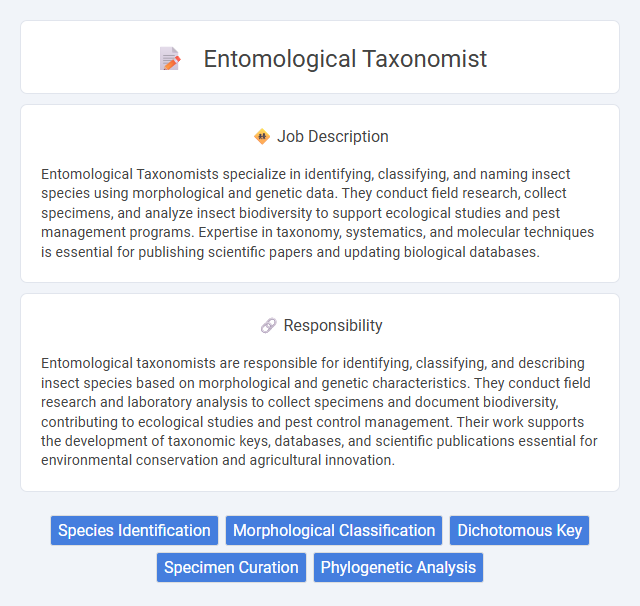
Entomological Taxonomists specialize in identifying, classifying, and naming insect species using morphological and genetic data. They conduct field research, collect specimens, and analyze insect biodiversity to support ecological studies and pest management programs. Expertise in taxonomy, systematics, and molecular techniques is essential for publishing scientific papers and updating biological databases.
Individuals with a strong interest in biology and detail-oriented personalities likely find the role of an entomological taxonomist suitable, as it involves meticulous examination and classification of insect species. People who enjoy working in laboratory and field settings and possess patience and analytical skills may have a higher probability of excelling in this job. Those who prefer fast-paced or less solitary work environments might find the nature of taxonomic research less compatible with their preferences.
Qualification
Entomological Taxonomists typically hold advanced degrees such as a Master's or Ph.D. in entomology, biology, or related fields, with extensive knowledge in insect classification and taxonomy. Proficiency in molecular techniques, such as DNA barcoding, and expertise in morphological identification using taxonomic keys are essential for accurate species determination. Strong analytical skills combined with experience in fieldwork, specimen collection, and data management are critical qualifications for this specialized scientific role.
Responsibility
Entomological taxonomists are responsible for identifying, classifying, and describing insect species based on morphological and genetic characteristics. They conduct field research and laboratory analysis to collect specimens and document biodiversity, contributing to ecological studies and pest control management. Their work supports the development of taxonomic keys, databases, and scientific publications essential for environmental conservation and agricultural innovation.
Benefit
An entomological taxonomist likely benefits from opportunities to contribute to biodiversity conservation through the identification and classification of insect species. They may experience professional growth by collaborating with research institutions and engaging in fieldwork that advances ecological knowledge. This role probably offers a rewarding sense of purpose by aiding in the development of pest control strategies and environmental protection efforts.
Challenge
The role of an entomological taxonomist likely involves complex challenges in accurately identifying and classifying insect species due to the vast diversity and subtle morphological differences among them. There is a probability that difficulties arise from the need to integrate molecular data with traditional taxonomy for precise species delimitation. Navigating limited reference materials and evolving taxonomic frameworks may further complicate the task, requiring continuous learning and adaptation.
Career Advancement
Entomological taxonomists advance their careers by specializing in insect classification, utilizing molecular techniques and phylogenetic analysis to discover new species. Gaining expertise in bioinformatics and collaborating with research institutions enhances their potential for leadership roles in biodiversity conservation projects. Continuous publishing in scientific journals and securing research grants are critical for progression into senior research or academic positions.
Key Terms
Species Identification
Entomological taxonomists specialize in species identification by analyzing morphological characteristics and genetic data to classify and differentiate insect species. They utilize microscopy, DNA barcoding, and phylogenetic methods to ensure accurate taxonomy essential for biodiversity studies and pest control strategies. Expertise in species identification supports ecological research, conservation efforts, and the development of biological control agents.
Morphological Classification
Entomological taxonomists specializing in morphological classification analyze the physical structures of insects to identify and categorize species accurately. They utilize detailed comparisons of anatomical features such as wing patterns, antennae shapes, and exoskeleton textures to differentiate between closely related taxa. Expertise in morphological traits supports biodiversity studies, pest control strategies, and ecological research by providing precise insect identification.
Dichotomous Key
Entomological taxonomists specialize in classifying and identifying insect species using tools such as dichotomous keys, which systematically guide users through paired choices leading to specific insect identification. Mastery of constructing and interpreting dichotomous keys enhances accuracy in distinguishing closely related insect taxa, supporting biodiversity research and pest management. Proficient use of these keys aids in documenting insect diversity, critical for ecological studies and conservation efforts.
Specimen Curation
Entomological taxonomists specialize in the identification, classification, and curation of insect specimens, ensuring accurate cataloging within scientific collections. Their expertise includes preserving specimens through techniques like pinning, slide mounting, and maintaining environmental conditions to prevent degradation. Proficient in morphological analysis and molecular methods, they contribute to biodiversity research and support ecological studies by managing entomological repositories.
Phylogenetic Analysis
Entomological Taxonomists specializing in phylogenetic analysis use genetic, morphological, and molecular data to classify insect species and unravel their evolutionary relationships. Employing techniques such as DNA sequencing and cladistic analysis, they construct phylogenetic trees to identify lineage divergence and species ancestry. Their work informs biodiversity assessments, conservation strategies, and the understanding of insect evolution within ecological systems.
 kuljobs.com
kuljobs.com